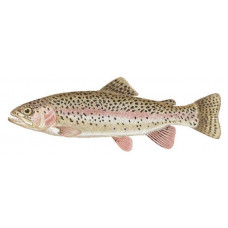Latin name
Oncorhynchus mykiss
Other names
No information
Identification
Among the most popular and well-known species of fish called trout are brook trout, brown trout, cutthroat trout, rainbow trout and lake trout. They have many strains, marine forms and hybrid variants. Some taxonomists argue that the brown trout is the only true trout because it was the first of its kind described by Linnaeus, the father of modern systematics, and that other fish species (especially in North America) have been called trout mainly because of a similar body shape. This is a question best left to scientists, but technically speaking, such well-known species as lake trout and brook trout are actually members of the charr group. So is the lesser known brown trout. Similarly, the rainbow trout and its anadromous steelhead, once classified as trout, are now members of the Pacific salmon group, as are the cutthroat trout, the lesser-known golden trout, and the Apache trout. As a rather primitive group of fish, trout have no spines on their fins. Most of the soft rays in the fins are branched. The pelvic fins are located far back on the body. This arrangement contrasts with the arrangement of the pelvic fins in many other species, such as largemouth bass, which have pelvic fins so far forward that they are almost directly under the pectoral fins. Other signs of primitiveness in trout are the presence of an adipose fin and a primitive air bladder. As a group, trout are among the most attractive and beautiful freshwater fish. Some are particularly colorful, especially during the spawning season, and most have distinctive markings on their bodies, although there are large variations depending on habitat. Within each species, there is considerable variation in coloration and patterning from river to river and between river and lake populations. For example, a brook trout living in a deep lake will be more silvery and rather dull compared to a brook trout caught in a rich limestone stream. The difference is so great that it is impossible to assume they are the same species. Like almost all members of the Salmonidae family, trout have suffered from human-caused changes. These include overfishing, pollution, habitat alteration, water warming, hatchery impacts, and competition from exotic species. Some local populations of various trout species and their subspecies or strains have declined dramatically or even disappeared, while others have declined, recovered, or expanded. Competition between species, especially between native and introduced trout, or between trout and other introduced species, has often been a major problem. Each of the major species is of great interest to anglers, although rainbow trout and brown trout are the most popular because of their adaptability to different habitats and wide international distribution. Trout are usually associated with fishing in rivers and streams.
Distribution
It includes species with a limited range, especially various strains and isolated populations that are little known to most people, and species that are distributed virtually all over the world. Rainbow trout is probably the most widely distributed sport fish in the world and has become an important food fish through aquaculture production. As a group, trout are one of the most widely farmed fish, perhaps second only to carp, which is the mainstay of fish farming in China. Trout are often farmed to replenish existing stocks, to restore species to waters where natural populations have been depleted, or to introduce them to waters where they were previously absent.
Habitat
As a group, these fishes are endemic to the freshwaters of temperate and cool regions of the Northern Hemisphere, but are also widely distributed outside their native range. Like most members of the Salmonidae family, trout are associated in one way or another with cold, often swift waters and high oxygen demand. Some species, including brown trout, cutthroat trout, and rainbow trout, are also associated with and spend part of their lives in the ocean. Pacific salmon, Atlantic salmon, and Arctic charr are examples.
Size
No information
Life history and Behavior
All trout spawn in fresh water and most require cold running water.
Food and feeding habits
No information
Reproduction
No information
| Classification | |
| Phylum | Chordata |
| Class | Actinopterygii |
| Squad | Salmoniformes |
| Family | Salmonidae |
| Genus | Oncorhynchus |
| Species | O. mykiss |
| Features | |
| Conservation status | Secure |
| Habitat | Pelagic |
| Life span, years | 11 |
| Maximum body weight, kg | 9 |
| Maximum length, cm | No information |
| Sailing speed, m/s | No information |
| Threat to people | Edible |
| Way of eating | Predator |
Trout: Rainbow Trout
Tags: Trout: Rainbow Trout



